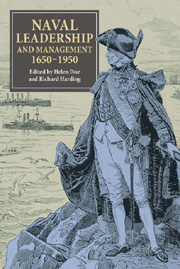Book contents
- Frontmatter
- Contents
- List of Tables
- List of Editors and Contributors
- Acknowledgements
- List of Abbreviations
- Michael Duffy: An Appreciation
- Introduction
- Leadership: The Place of the Hero
- Leadership and Organisational Frictions: Contested Territories
- 3 Who has Command? The Royal Artillerymen aboard Royal Navy Warships in the French Revolutionary and Napoleonic Wars
- 4 ‘The Marine Officer is a Raw Lad and therefore Troublesome’: Royal Naval Officers and the Officers of the Marines, 1755–1797
- Management Capability and the Exercise of Naval Power
- The Evolution of Management Training in the Royal Navy, 1800–1950
- Select Bibliography
- Index
3 - Who has Command? The Royal Artillerymen aboard Royal Navy Warships in the French Revolutionary and Napoleonic Wars
from Leadership and Organisational Frictions: Contested Territories
Published online by Cambridge University Press: 05 February 2013
- Frontmatter
- Contents
- List of Tables
- List of Editors and Contributors
- Acknowledgements
- List of Abbreviations
- Michael Duffy: An Appreciation
- Introduction
- Leadership: The Place of the Hero
- Leadership and Organisational Frictions: Contested Territories
- 3 Who has Command? The Royal Artillerymen aboard Royal Navy Warships in the French Revolutionary and Napoleonic Wars
- 4 ‘The Marine Officer is a Raw Lad and therefore Troublesome’: Royal Naval Officers and the Officers of the Marines, 1755–1797
- Management Capability and the Exercise of Naval Power
- The Evolution of Management Training in the Royal Navy, 1800–1950
- Select Bibliography
- Index
Summary
Warfare is much more than battles, operations, admirals and generals. This was as true in the long eighteenth century as it is today. Essential to any victory, either at sea or on land, are adequate and guaranteed logistics, a firm administrative structure and clear lines of command. This chapter will examine the latter two areas during the French Revolutionary and Napoleonic Wars. It is not possible to present a full study of these in one chapter so the case study of Royal Artillerymen serving on Royal Navy warships will be used to exemplify the larger issues.
In the period under examination the military forces of Great Britain had three different, and very distinct, command structures: there was the navy run through the Admiralty; the artillery and engineers run through the Office of Ordnance; and the army run through the Commander-in-Chief and the War Office. Each of these three departments needed to communicate and co-ordinate their actions if the British war effort was to succeed. However, the true story was far more complicated than this: food and drink for the officers and men was provided by the Victualling Board, transport was provided by the Transport Board and weaponry was provided by the Office of Ordnance. In addition, the Navy Board was also involved in fitting out warships when they were commissioned.
Each of these boards was involved when artillerymen served at sea. They were fed by the Victualling Board, although as will be shown they were not part of the official crew and so were carried as supernumeraries.
- Type
- Chapter
- Information
- Naval Leadership and Management, 1650–1950 , pp. 61 - 76Publisher: Boydell & BrewerPrint publication year: 2012



